Why I Stopped Making Bone Broth at Home
This is the ultimate street-smart guide to bone broth, including everything you need to know about bone broth, the best homemade bone broth recipes, and what to look for when buying ready-to-drink bone broth products.
Growing up in China, I had very early access to bone broth, which nowadays is considered a superfood. My mom used to make bone broth for me whenever I was sick or had an injury, which apparently happened quite often. I wasn’t an athlete per se, but I was an extremely active kid. The kind who worries the parents all the time.
My mom’s homemade bone broth got me through a lot of physically tough times, including two arthroscopic knee surgeries and 11 stitches on my face from a fall in the mountains. But little did I know that a traditional food I took for granted almost my entire life would become a trendy food in the health and wellness industry.
As someone who knew firsthand the benefits of bone broth, I started digging into the subject more deeply, making my own bone broth at home, something that I eventually stopped. In this article, I will explain exactly why I stopped making bone broth at home. First, though, it’s important to understand what bone broth is because it’s not the normal stock you typically use in your cooking.
- What Is Bone Broth?
- Normal Stock vs. Broth vs. Bone Broth: What’s the Difference?
- Bone Broth Benefits
- How to Make Bone Broth at Home
- Beef Bone Broth Recipe
- Chicken Bone Broth Recipe
- Why I Stopped Making Bone Broth at Home
- How to Choose Ready-to-Drink Bone Broth in a Store
- StreetSmart Kitchen’s Choice – Kettle & Fire Bone Broth
- How to Include Bone Broth in Your Daily Cooking
- 5-Minute Egg Drop Soup
- Where to Buy Kettle & Fire Bone Broth
- About the Author
What Is Bone Broth?
Bone broth is made with bones that have a small amount of meat attached to them. Along with a few vegetables, herbs, spices, and apple cider vinegar, the bones are covered in water and slowly simmered for 12-48 hours, depending on whether it’s beef bone broth or chicken bone broth. Beef bone broth needs more time to break down the nutrients in the bones, whereas the smaller chicken bones generally require less simmering time. The liquid result of long hours of simmering is bone broth.
Over the past few years, bone broth has gained a superfood status, having a nutrient profile that benefits all kinds of health ailments, from chronic digestive to autoimmune conditions. Not only can you find cookbooks and cleanses dedicated to bone broth, such as Dr. Kelly Ann’s Bone Broth Diet, but many restaurants also use bone broth in their recipes and serve it as a beverage on their drink menus.
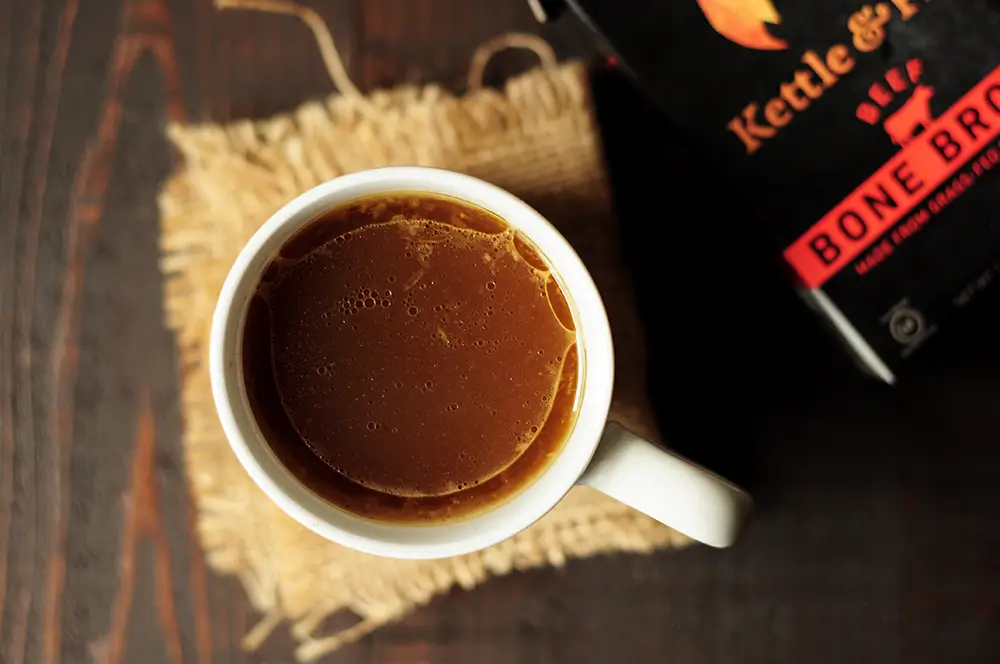
Bone Broth as a Drink
My mom fed me bone broth back then in some kind of soup. I had never thought about drinking bone broth straight until a year ago.
Surprisingly, by simply adding some salt and pepper, bone broth can become an easy drink in the morning to pair with your breakfast or a night-time elixir to help you sleep better.
Over time, I’ve learned to get creative with the spices I put in my bone broth each time. Turmeric, paprika, poultry seasoning, and mesquite seasoning are all regulars in my bone broth, which keeps the drinking experience interesting and different each time.
Bone Broth as a Cooking Liquid
Of course, bone broth is a fantastic cooking liquid. Basically, anytime you need water or stock in a recipe, you can substitute bone broth. For example, instead of using normal beef stock in the classic French Onion Soup Recipe or Mongolian Beef, try it with beef bone broth. The flavor gets much richer, as well as the nutrient content, including collagen, calcium, iron, etc.
Now you might wonder, what’s the difference between normal stock, broth, and bone broth?
Normal Stock vs. Broth vs. Bone Broth: What’s the Difference?
I couldn’t find a better resource than this article to explain the difference between a normal stock, a broth, and a bone broth. Here’s a short summary.
A stock is made by boiling bones, ligaments, and connective tissue in boiling water for roughly 3-4 hours. That’s how store-bought beef or chicken stock is made. The thing that concerns me the most is the source of the ingredients. I’ve heard that they usually use crappy bones, and it’s highly possible that the stock contains the pesticides, hormones, and other toxins present in sick animals.
A broth is a more translucent liquid that’s made primarily from meat scraps, such as chicken or beef. A broth has a lighter, thinner consistency compared to stock and is simmered for 45 minutes to two hours. Sound familiar? You may have made chicken or beef broth at home or made vegetable broth by using the leftover water from boiling or blanching your veggies.
A bone broth is a stock because it’s made from boiling bones, ligaments, and connective tissue for extended periods of time, and it has a thicker texture. Bone broth is different from a normal stock because it’s simmered much longer—between 12 and 48 hours—to release as many nutrients as possible from the bones.
Since the terms “stock” and “broth” are often used interchangeably, somewhere along the way, the bone stock became bone broth, and the name stuck.
Bone Broth Benefits
We all know that bones are the storehouses of essential nutrients such as calcium and magnesium. They’re also the world’s best source of collagen and gelatin, two nutrients that can make a big difference in your skin, joints, and gut health.
Simmering the bones for at least 20 hours also helps to release the amino acids proline, glycine, and glutamine, which further support joint and gut health and reduce systemic inflammation. Best of all, the prolonged simmering allows all of the beneficial nutrients in bone broth to become more bioavailable, which means they’re incredibly easy for our body to digest and absorb.
In a nutshell, the key benefits of bone broth are listed below.
- If you are suffering from arthritis or any joint pain, as I did due to my arthroscopic knee surgeries and the two rivets implanted in each of my knees, drinking bone broth is going to improve your joint health and reduce the discomfort significantly.
- If you have digestive disorders such as leaky gut syndrome, you’ll need essential nutrients like L-glutamine, amino acids, and minerals for healing. Guess which food is rich in these? Bone broth.
- If you’d like a glowing skin from the inside out, use bone broth to improve digestive health first, because our natural beauty is closely connected to our guts.
- If you are pregnant or you are ready to get pregnant, besides dairy products, bone broth is a great source of calcium. Remember, if you don’t get enough calcium from your diet, it won’t affect your baby’s development, because your baby will just take the calcium it needs from your bones.
- You’ve heard the word “collagen.” It’s a special profile of amino acids found in our connective tissue. It boasts an impressive resumé, complete with crucial responsibilities like replacing dead skin cells, improving digestive function, and holding the body together—literally. But our bodies naturally slow down on collagen production as we get older. To compensate for the decline of production within our bodies, bone broth does an excellent job.
- Because bone broth is rich in collagen, it helps prevent and get rid of stretch marks naturally. You don’t need those expensive creams, Mama!
- Bone broth promotes detoxification and decreases hangover effects.
- Bone broth helps you fall asleep and stay asleep.
How to Make Bone Broth at Home
Now that you understand why you should take bone broth regularly, are you wondering how to make bone broth at home? Here are my favorite recipes for beef bone broth and chicken bone broth. I recommend using a slow cooker to make the cooking process almost completely hands-off.
Beef Bone Broth Recipe
Print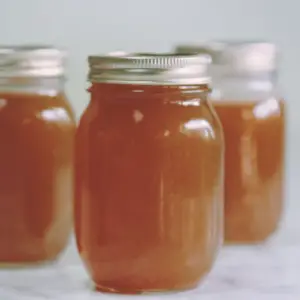
Beef Bone Broth Recipe
- Prep Time: 15 minutes
- Cook Time: 23 hours 45 minutes
- Total Time: 24 hours
- Yield: 4 quarts 1x
- Category: Bone Broth, Soup
- Method: Slow Cooker
- Cuisine: Chinese
Description
Organic beef bone broth made in a slow cooker.
Ingredients
- 3–4 pounds of mixed grass-fed beef bones (marrow bones, oxtail, knuckles, short rib, etc.)
- 2 medium onions, chopped
- 2 medium carrots, chopped
- 3 celery stalks, chopped
- 2 bay leaves
- 2 tablespoons apple cider vinegar
- 1 tablespoon peppercorns
- 8–10 cups water (or enough to cover ingredients)
Instructions
- Heat oven to 400°F.
- Place the mixed bones in a roasting pan in a single layer and place it into the oven. Roast the bones for 30 minutes. Turn bones over and roast another 30 minutes.
- While the bones are roasting, chop the onions, carrots, and celery. You are going to discard these after long hours of cooking, so a rough chop works great!
- Place roasted bones, chopped vegetables, bay leaves, apple cider vinegar and peppercorns in a 6-quart crockpot. Cover completely with water.
- Cover and cook on low for 24 hours. Add water as needed to keep all the ingredients covered in water and periodically skim the foam off the top of the pot.
- After 24 hours, the broth should be a dark brown color. Discard all solids and strain the broth through a fine mesh strainer into a large bowl. Strain once more through cheesecloth to remove any remaining particles if desired.
- Ladle the bone broth into Mason jars and let it chill to room temperature. Bone broth can be stored in the fridge for up to two weeks or frozen for future use. Before using, skim off the accumulated fat on the surface.
Nutrition
- Serving Size: 1 cup
- Calories: 133
- Sugar: 1.1g
- Sodium: 155.8mg
- Fat: 7.8g
- Carbohydrates: 2.3g
- Protein: 11.2g
- Cholesterol: 31.8mg
Chicken Bone Broth Recipe
Print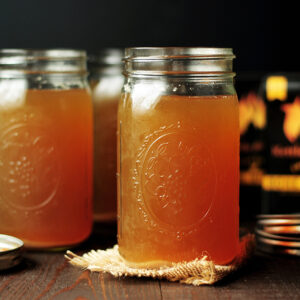
Chicken Bone Broth Recipe
- Prep Time: 15 minutes
- Cook Time: 12 hours
- Total Time: 12 hours 15 minutes
- Yield: 4 quarts 1x
- Category: Bone Broth, Soup
- Method: Slow Cooker
- Cuisine: American
Description
Hearty chicken bone broth made in a slow cooker.
Ingredients
- 2 pounds chicken bones (leftover from roasted chicken, preferably organic)
- 1 yellow or white onion, roughly chopped
- 2 ounces fresh ginger, sliced
- 2 tablespoons apple cider vinegar
- 1 tablespoon whole peppercorns
- 2 bay leaves
- 8–10 cups of water (or enough to cover ingredients)
Instructions
- Place chicken bones and all remaining ingredients into a slow cooker and cover with water.
- Cover and cook on low for 12-18 hours.
- Discard all solids and strain the bone broth through a fine mesh strainer into a large bowl. Strain once more through cheesecloth to remove any remaining particles if desired.
- Ladle into airtight jars and store in the refrigerator for up to two weeks, or freeze for future usage.
Note: chicken bone broth requires less cooking time than beef bone broth because chicken bones are much smaller, and it’s easier to release nutrients.
Why I Stopped Making Bone Broth at Home
It looks like I’ve cracked the code of how to make a good and rich bone broth every single time, right? I learned what ingredients to buy, what kitchen tools I need, the best way to cook bone broth, and how long to cook it for best results. Eventually, it became my weekly routine. After a few solid months of making bone broth at home every week, however, I decided to stop. The real question is: Why?
It’s hard to source good bones.
To make good bone broth, you need good bones. Let’s be honest. If you are going to make the effort and spend the time to make bone broth at home, you might as well get the most out of it in terms of benefits and taste. Otherwise, why bother?
Good beef bones are grass-fed and ideally grass-finished marrow bones, oxtails, knuckles, neck bones, and feet. When making chicken bone broth, I’d be looking for organic, free-range chicken and chicken feet.
Most of our local grocery stores either don’t have the variety of bones or don’t carry grass-fed bones.
When I was living in Jacksonville, FL, the closest butcher shop was 30 minutes away by car, and it was not guaranteed to have what I needed every time.
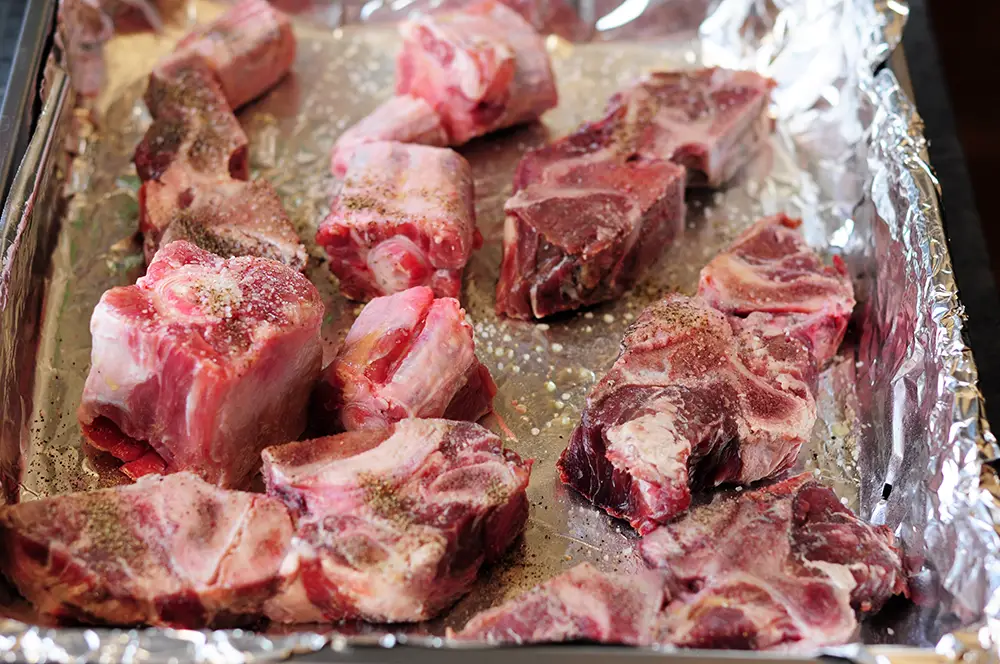
When we moved to Austin, TX, we were lucky, and there was a huge Asian market right next to where I lived. The ginormous meat counter had all the bones you could possibly think of. They also offered a 5-pound bag with mostly knuckles and a couple of marrow bones with a price tag of $0.99 per pound. Affordable? Hell yeah! Quality? I was skeptical.
It takes too much time.
Wait! Isn’t most of the work done by a slow cooker? Why does it still take too much time?
That’s what I thought too. After making countless batches of bone broth, I discovered that cooking was not the problem, because I was completely hands-off during those long hours. However, aside from the time spent on sourcing the good ingredients and preparing them, straining and storing the bone broth wasn’t easy-peasy.
First, you need to remove the bones and vegetables. Then you strain it through a fine mesh strainer. Don’t forget that you are either going to lift a 7-quart stoneware crock nearly full of broth (oh, it’s heavy!), or you are going to ladle the broth through the strainer repeatedly. If you want your bone broth to be extra smooth and silky, you’ll want to strain it again through a cheesecloth before ladling it into Mason jars.
At this point, you’ve probably made a mess on your kitchen counter, leaving some large pots and bowls to wash.
The next step is to properly store the bone broth, which brings me to my next point.
Mason jars take up too much space in my fridge.
The goal of making bone broth is to make a big batch. Jars of bone broth can take up a lot of space in the fridge and/or freezer. I don’t know about you, but my fridge is usually full, and making room for a few 32-ounce jars is a real stretch.
There are other ways of storing your bone broth without Mason jars, such as the Ziploc bag method and the silicone muffin tin method. You’ll then need to free up some space in your freezer for the frozen bone broth.
The nutrients in homemade broth varied every time, depending on the quality of my ingredients.
In order to maximize the results of the efforts I put into making a batch of homemade bone broth, I tended to choose high-quality ingredients, such as grass-fed and grass-finished beef bones, organic vegetables, herbs, and spices. However, it was not guaranteed that I’d be able to source good bones every time, not to mention that it easily got to be very expensive.
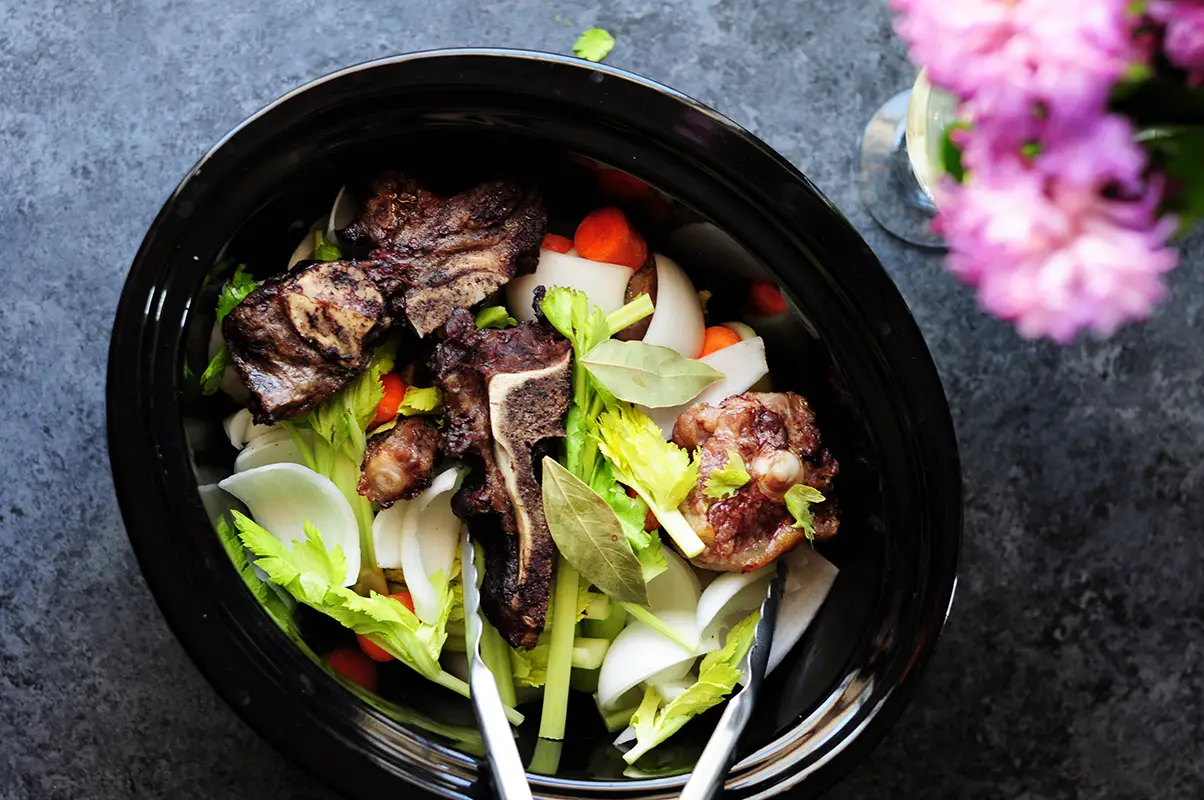
Therefore, every batch of bone broth I made most likely had different amounts of nutrients. One batch could have more collagen and protein, and another batch might have less. One batch could have more calcium, another batch less. There’s no way to find out the exact values unless I did a lab test for each batch, which was not going to happen. But I was certain that the benefits of my homemade bone broth were inconsistent.
It’s not much cheaper than buying pre-made, ready-to-drink bone broth.
Let’s look at how much I spent on buying ingredients for a batch of homemade beef bone broth first.
One pound of split, 100% grass-fed, organic beef marrow bone in Whole Foods Market costs $7.99. Regular marrow bones cost around $5-$6 per pound. Oxtail is about $7 per pound and knuckle bones are around $3-$4 per pound.
If I want to make 10-12 cups of beef bone broth, I will need at least three pounds of mixed bones. Again, to make my efforts worth it, I’d want to go for the best quality ingredients. For my bones only, that’s almost $18. Adding the cost of vegetables, spices, herbs, and apple cider vinegar, one batch of beef bone broth cost me about $20.
To make things easy, say it yields 10 cups of beef bone broth. That’s $2 per cup.
That’s not too bad. Still way cheaper than buying ready-to-drink bone broth, you say.
How much is our time worth? That’s where making bone broth at home becomes costly. From buying ingredients to making the bone broth, to storing one batch of bone broth, let’s conservatively say that it takes an hour. (It’s probably longer than that). Add your hourly rate to the total cost. If it’s $40 per hour, that liquid gold (no pun intended) you make now costs $6 per cup.
Of course, if you have the time or enjoy the process of making bone broth, it’s all worth it. Otherwise, it doesn’t hurt to take a look at what pre-made bone broth is available on the market and see if it meets the requirements of us home cooks.
How to Choose Ready-to-Drink Bone Broth in a Store
Not all bone broths are created equal. When choosing pre-made bone broths at your local grocery store, here are a few things that you should look at before you open up your wallet.
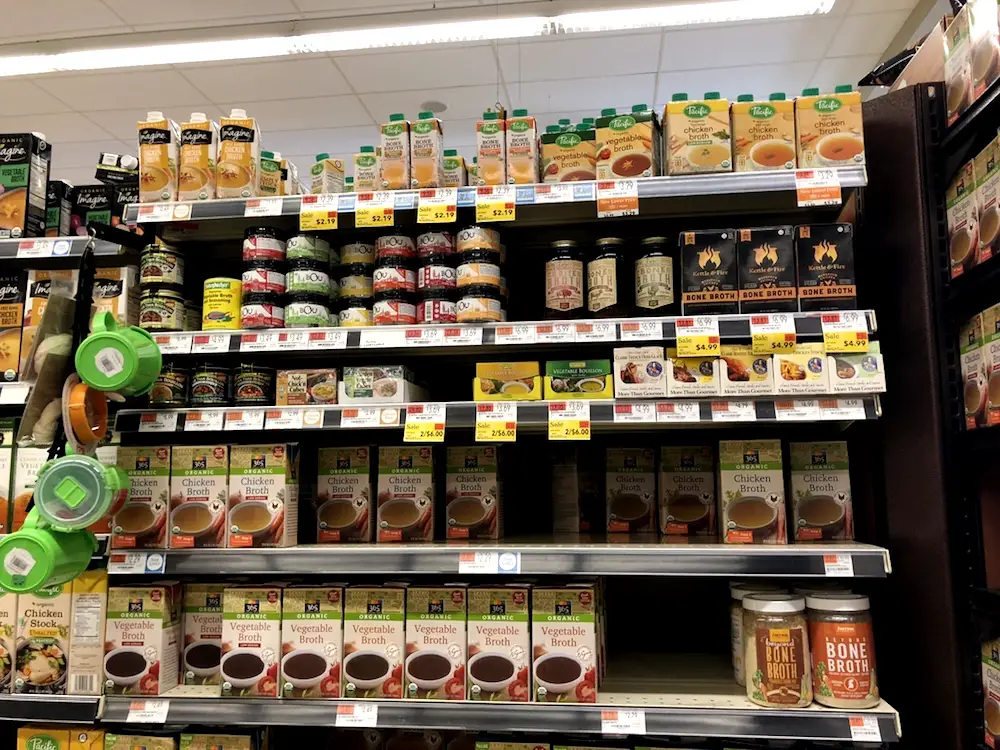
Is “Bone Broth” on the Label?
Grocery stores usually place bone broths, regular stocks, and canned soups in the same aisle. So if the phrase “bone broth” is not clearly stated on the packaging or label, that item is not what you are looking for.
As I mentioned earlier in this article, bone broth is made with bones and slow-simmered for a very long time in order to draw out all the nutrients from the bones. That’s how you can consume essential nutrients like collagen and amino acids naturally. Regular stocks aren’t made with bones. They are not simmered for long times. Hence, no benefits.
So look for “bone broth” on the label.
Are There Bones? What Type?
Some of the so-called bone broth products on the market don’t even have bones in their ingredient lists. Please skip those immediately. You are not going to get any bone broth benefits without the bones. It’s that simple.
OK, say you find the bones on the ingredient list. Great! What type of bones?
When buying beef bone broth, see if the product uses grass-fed and ideally grass-finished bones. Grass-finished cattle ate a grass diet throughout their entire lifespan. The cattle never ate any soy or corn. Those animals’ bones contain much more anti-inflammatory Omega 3 essential fatty acids than the cattle that were fed a mixture of soy and corn. When purchasing chicken bone broth, you want to look for organic chicken bones.
In other words, the higher the quality of the bones, the more benefits in the bone broth.
And bones should be higher up in the ingredient list, followed by water because those are the two most essential ingredients for making bone broth.
How Long Is It Simmered?
Bones, check.
Organic grass-fed and grass-finished bones, check.
Now, look at the description on the back of the packaging. Does it say it’s simmered for more than 10 hours? If not, the product might not be what you are looking for.
I can’t stress the long simmer time strongly enough.
A couple hours of cooking simply is not enough time to draw out all the powerful nutrients in bones. Chicken bone broth needs 10-12 hours of simmer time. For beef bone broth, 20-24 hours are minimal, because it takes that long to break down the bones. Period.
Any Added Additives and Preservatives?
When you make bone broth at home, you don’t add any additives or preservatives. If you buy pre-made bone broth that contains additives and preservatives, it defeats the whole point. You might as well make bone broth at home.
So try to avoid bone broths that contain items like yeast extract or lactic acid.
On that note, I’d recommend you stay away from powdered bone broth, as you are more likely to ingest heavy metals and/or chemical additives, even though they don’t usually list those on the food label.
Bonus Points
Just like homemade bone broth, most bone broth companies add vegetables, herbs, and apple cider vinegar when making bone broth. Are all of the ingredients organic? If so, that’s a huge plus.
Last but not least, packaging! Is it recyclable?
Yes?! Good for the environment. Bonus points again!
StreetSmart Kitchen’s Choice – Kettle & Fire Bone Broth
I followed the exact steps mentioned above to look for pre-made, ready-to-drink bone broth in Whole Foods Market. I have also tasted every single bone broth brand out there. The product that literally checks off all the boxes and tastes the best is Kettle & Fire Bone Broth, America’s first and only USDA grass-fed bone broth.
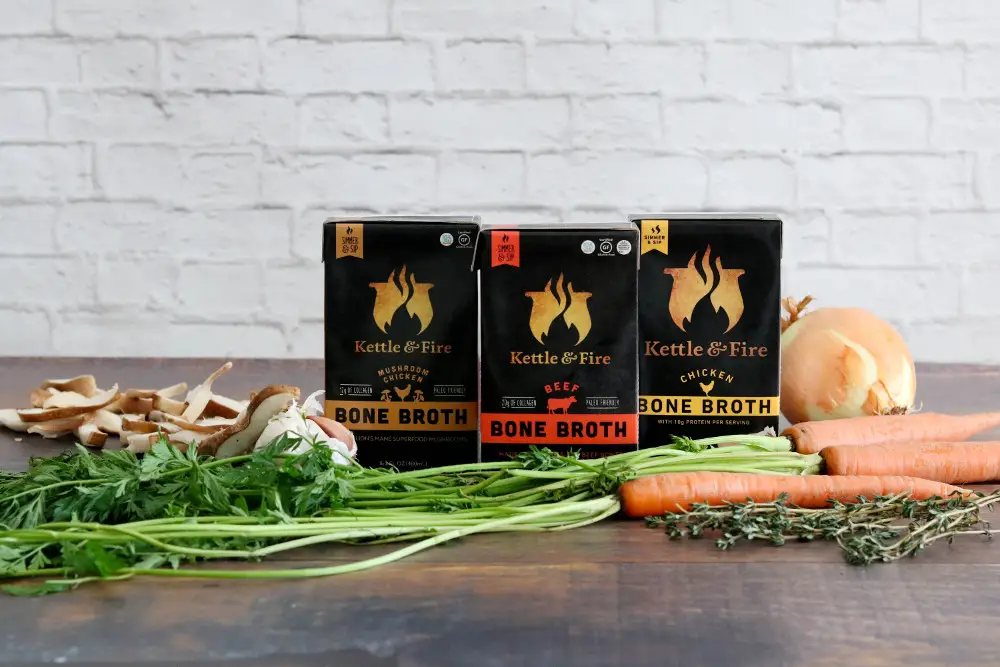
If you hold a carton of Kettle & Fire Bone Broth in your hand, you will notice that the company put a ton of effort into ensuring the quality of their products, and it shows with all the details they cover.
- First and foremost, they use grass-fed beef bones, including marrow bones and knuckles, etc.
- They use a slow, low-heat cooking process that lasts for more than 24 hours, which gives the precious marrow, collagen, and amino acids time to release into the beef bone broth.
- Their chicken bone broth starts with free-range, organic chicken bones, which they are proud to source from small USA family farms that never use hormones or antibiotics.
- The only other ingredients that they add to the mix are organic vegetables, sea salt, and herbs. This means no artificial ingredients, no preservatives, and no additives.
- They use state-of-the-art packing technology so that you can stock up their bone broth and keep it in your pantry for up to two years unopened.
Sounds too good to be true? A trip to the factory allowed me to watch how exactly the Kettle & Fire Bone Broth is made, which doubly confirmed my thought—this might be the best bone broth product on the market.
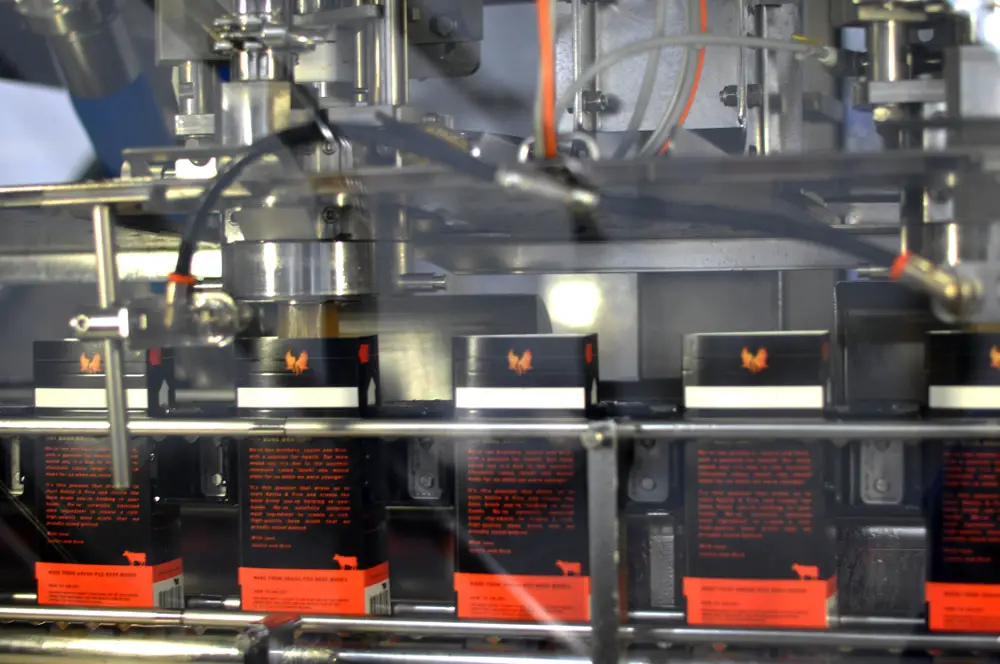
How to Include Bone Broth in Your Daily Cooking
Ever since I learned about the amazing health benefits that bone broth provides, I have been gradually using bone broth more and more to consistently get the powerful nutrients daily.
If you are not a fan of drinking bone broth directly, incorporate it into your daily cooking instead. You’ll still get all the bone broth benefits without even having to think about it.
How?
Anytime you see a recipe that calls for regular stock, broth, or water, replace it with bone broth.
I promise that result of your cooking will be the same—or even better because the bone broth will give your dishes a more savory and meaty flavor. Here are a few ideas for inspiration.
Authentic Pho with Zucchini Noodles
Healthy Mexican Rice
Mongolian Beef
Seafood Quinoa Salad
Slow Cooker French Onion Soup
Bone Broth Bloody Bull
Super Easy Mussel Recipe with White Wine Sauce

5-Minute Egg Drop Soup
- Prep Time: 2 minutes
- Cook Time: 3 minutes
- Total Time: 5 minutes
- Yield: 2 cups 1x
- Category: Soup, Gluten Free
- Method: Stove
- Cuisine: Chinese
Description
Legit Chinese-style egg drop soup that takes 5 minutes to make and it’s nutritiously delicious!
Ingredients
- 2 eggs, beaten
- 1 tablespoon cornstarch
- 2 tablespoons cold water
- 1 carton of Kettle & Fire Bone Broth
- 1 stem green onion, chopped
- Salt to taste
- Sesame oil to taste
Instructions
- In a small saucepan, bring beef bone broth to a boil.
- In the meanwhile, beat the eggs in a small bowl, dissolve cornstarch in cold water in another small bowl, and chop the green onion. Set aside.
- Once the broth is boiling, stir in dissolved cornstarch, followed by the beaten eggs. Then immediately start stirring so that the eggs are evenly distributed in the broth; stir constantly for 30 seconds, or until the soup is thickened.
- Turn off the heat; taste and add a pinch a salt if desired. Dish, drizzle with sesame oil and garnish with green onion. Serve immediately.
Where to Buy Kettle & Fire Bone Broth
Before I moved to Hong Kong, I always had a few cartons of Kettle & Fire bone broth in my pantry at all times. At the time this post is being written, Kettle & Fire ships only within the United States. I hope and believe that one day Kettle & Fire Bone Broth will be more accessible to the international market and more and more people around the world will benefit from their amazing bone broth products.
If you are interested in giving Kettle & Fire Bone Broth a try (I highly recommend it), here’s where to buy.
You can buy Kettle & Fire Bone Broth products online directly from their website or on Amazon.
Or go to major grocery stores like Whole Foods Market, HEB, etc. Use the Kettle & Fire Store Locator to find a store that’s close to you.
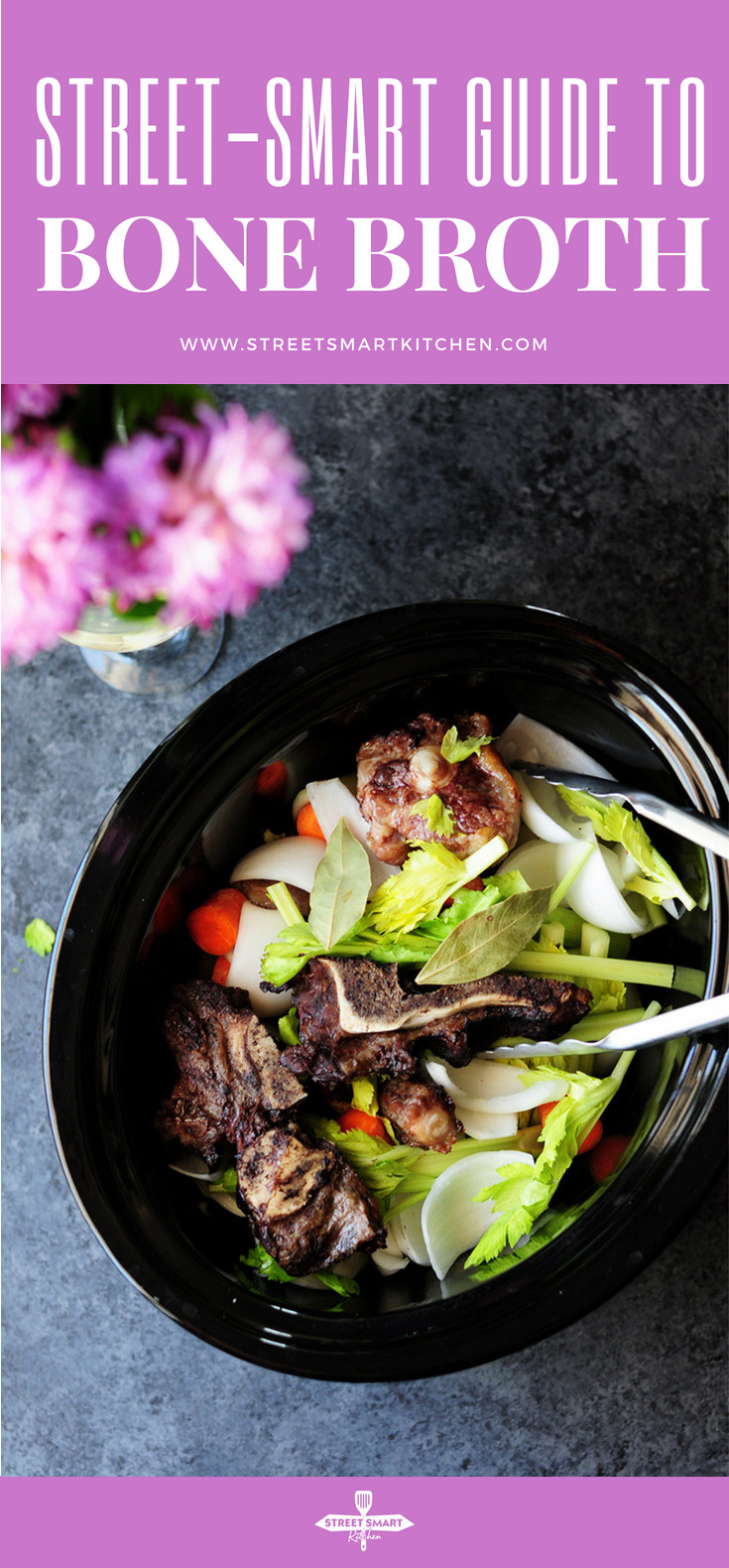
Disclaimer: I was a full-time employee at Kettle & Fire. I did not write this article solely to promote my former employer’s product, nor did I receive any compensation for writing this article. All opinions regarding bone broth are mine and are based on my experience, which I hope you find helpful. Some of the links in this article are affiliate links. If you decide to purchase any products through those links, I’ll receive a very small percentage of the commission at no extra cost to you. For that, I thank you!
About the Author
Sharon Chen is an Integrative Nutrition Health Coach and author of the Complete Sous Vide Cookbook. She believes food not only brings healing but also connection. As the creator of StreetSmart Kitchen, she aims to make meal prep easier than ever and help you find balance, ease, joy, and simplicity in the kitchen as you improve your well-being.



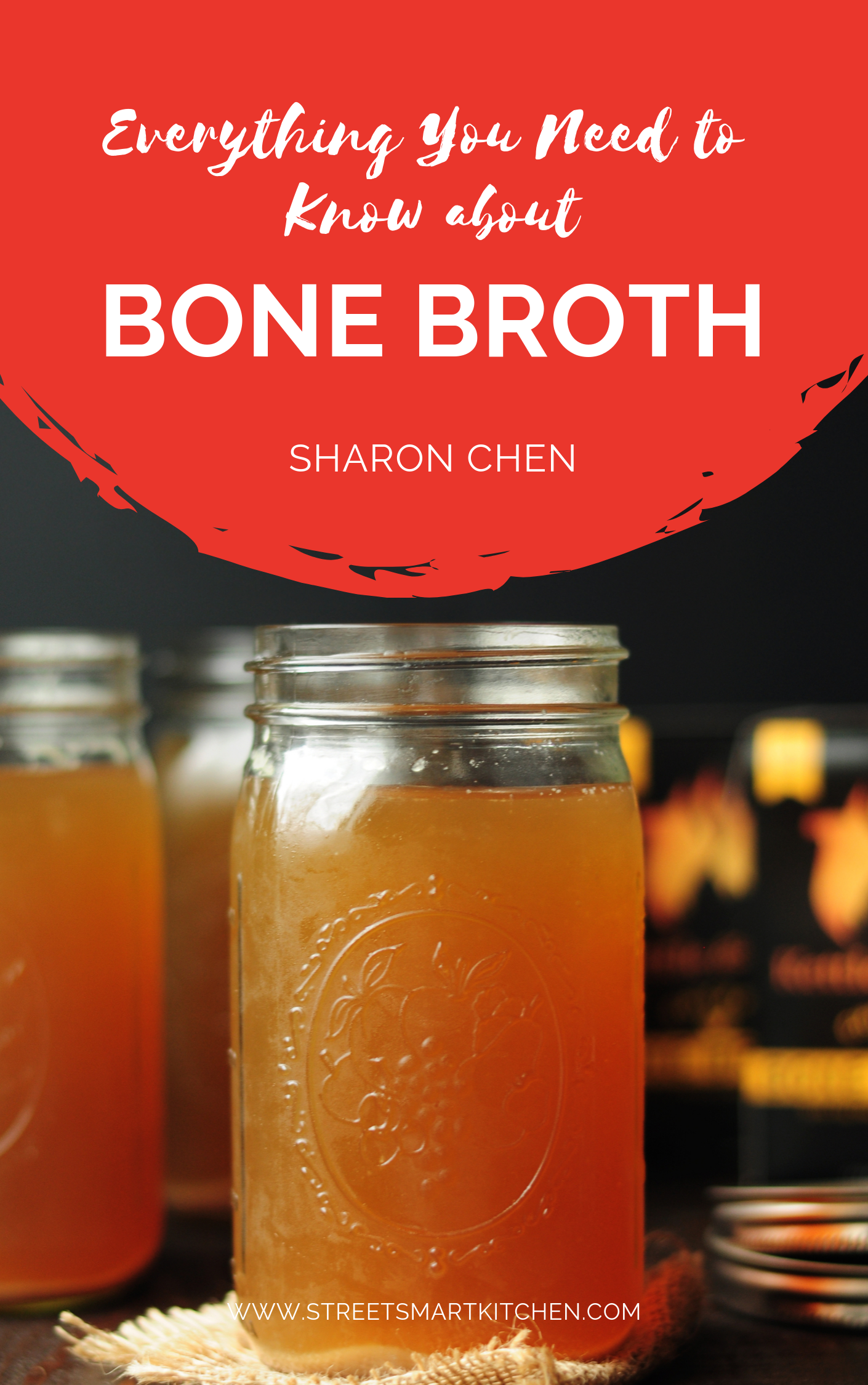
Pingback: How to Use a Knife for Cutting Bone (3 Easy Methods)
Interesting article and comments. My question is about instant pots- do they work as well for bone broth as the long slower cooking to extract the maximum benefits/nutrients?
Thanks!
I think this article answers your question precisely: https://blog.kettleandfire.com/instant-pot-bone-broth-recipe/
Pingback: Does Blanching Bones Remove Nutrients – Power Up Cook
Pingback: Top 29 Bone Marrow Food Cost - Lastest Updates - Smokerestaurant.com
Pingback: How To Cut Beef Bones At Home - Learners Guidance
When home making and home canning bone broth, every single thing I have read says that it has got to be pressure canned to make it shelf stable, if you are not freezing it, yet on the Kettle & Fire website, the bone broth is not packaged in glass. It seems pretty obvious to me that it has not been pressure canned so I don’t understand how this can be. I am in the process right now of making beef bone broth and am simply trying to find out one way or another, without a doubt, whether or not I have to pressure can it if I want it to be shelf stable as I am making a large quantity of it and do not want to put it in the freezer.
Can you please tell me where it was in Austin where are you found a good source of bones? That’s where I am and I would love to try making us at home but need to know where to find the best bones. Thank you!
Hi Barbara, I left Austin in 2018, so I am sure there are better places to get good bones that I might not be aware of. However, while I was living in Austin, the north part, to be specific, the Asian supermarket called MT Supermarket on North Lamar was where I got my beef bones from. They are fresh and very affordable. Whole Foods sells marrow bones. I used to put one or two of these along with the ones I got from MT to make a big batch of bone broth. Hope that helps.
I don’t know where you got your information from, however you’ve got it backwards.
A broth is made from *unroasted, uncooked* bones and collagen rich pieces like feet. It is cooked anywhere from 4 hours to a few days. It is made without veggies or seasonings, and always turns into a jello after cooling. It is always very light and pale in color, regardless of the specific animal being used.
A stock is usually made with *roasted, cooked* bones, possibly meaty ones, veggies, and is cooked for less time, Usually only a couple hours. Unlike broth, A stock can also be made without bones, for example if you’re making a veggie or mushroom stock. A stock isn’t usually prone to gelling and is usually quite a bit thinner, as well as much darker in color.
A good reference is:
Broth = Uncooked Bones Only, always jelly when cooled, Pale in color.
Stock = Cooked Bones and/Or Veggies, usually liquid when cooled, Dark in color.
THOUGHTS ON DR. KELLYS ANNS BROTH??
Grass fed and grass finished bones do not actually have more Omega 3 fatty acids. They have LESS Omega 6 fatty acids which means the broth you make from these bones is more Omega fatty acid BALANCED. Animals that are fed grain at any time of their lives will have a fatty acid IMBALANCE, with omega 6 overpowering the omega 3 by as much as 20-1. This is a major reason Americans are encouraged to seek out foods that are rich in omega 3 fatty acids like fish and grass fed and finished meats. Because our diets here are driven by grain finished meats and grain itself in nearly everything, We suffer the consequences of an imbalanced fatty acid profile, which is proven to be a driver of chronic inflammatory conditions.
My point here is that even the most carefully crafted bone broths made with organically grown chickens cannnot possibly be made to attain a balanced fatty acid profile that is healthy, much less a superfood, for human consumption simply because they are, at least in part, grain fed. There is only one ranch I know of in the USA that is addressing this issue by raising pastured hens in plots specially planted with fodder that is high in omega 3 fatty acids. They still have to supplement in cold times when the ground is covered in snow but they are located in Texas so that doesn’t happen often or for long periods. They also have control of the supplemental feed, adding ingredients that promote balanced profiles. Still, the best they have achieved is a 2:1 ratio. This is the only chicken I use so it’s easy for me to create a better balance by having chicken product one meal and fish the next.
However, most folks don’t use these products because they are expensive. They can buy three organic hens at the supermarket for the price of one hen that is organic and omega-fatty acid balanced. We need more ranchers willing to understand the importance of raising meat and fowl in ways that promote fatty acid balance before we can claim that certain broths are, indeed, superfoods or even healthy to consume.
I have tried your company’s beef bone broth and, I agree, it’s pretty outstanding. The best I’ve found on the market and as good as my own homemade. However, the chicken broth, no matter how tasty (and it is), remains squarely outside the category of superfood. I wish more people were aware of this fact but that information runs counter to for-profit business models in my country and is only available to those who search for it. Unfortunately, by the time folks look, they are already suffering from disorders caused by omega fatty acid imbalances. To be honest, most people in my country are already doomed from over consumption of grain products and imbalanced meats just add insult to injury. We’ve also spent an inordinate amount of energy attempting to “Feed the World” the past half century, passing our bad habits and ignorance around the globe in developing nations. Maybe you can stoke up some interest in China to help remedy the status quo. We are fighting the good fight here in the USA, but it is an uphill battle. Even Bill Gates seems to be on the wrong track.
Omega-fatty acid balanced chicken sounds amazing. But even organic chicken is a distant dream where I live.
But isn’t the fatty profile irrelevant for bone broth – as you’d skim the fat layer?
What a well written and informative article!
Thanks for sharing with the universe.
Not Transparent.
1. Why not start the article with “I was a full-time employee at Kettle & Fire” and this is how I found out about this great product.
2. Again you had a chance to disclose it in the middle of the article at “Sounds too good to be true? A trip to the factory allowed me to watch how exactly the Kettle & Fire Bone Broth is made, which doubly confirmed my thought—this might be the best bone broth product on the market.” Very misleading. You were not researching for the best bone broth company you worked for them.
3. I am a Biology Professor with a PHD in Nutrition. I want to know the breakthrough science behind storing food that does not changes its molecular composition and spoils on a shelf for 2 years without any additives and preservatives? That’s 17,520 hours.
4. Convenience is the only takeaway here. Just as convenience is for me to go to McDonald’s and get a Salad. As it is for one of us who travel and maybe then would benefit from on a road necessity.
Advertisements is what this article is. Please respond.
Hi Carroll, thank you for your comment and I hear your point. To clarify, being a full-time employee at Kettle & Fire was NOT how I found out about their bone broths. It’s actually the opposite. My goal for this article is to include all my knowledge and experiences with bone broth, so people can have the info they need to decide what they would like to do – whether it’s making bone broth at home or buy RTD bone broth, or simply just learn about bone broth.
As for the breakthrough science behind their packaging that you are looking for, hope this helps: https://www.kettleandfire.com/pages/why-our-bone-broth#fresh
Furthermore, feel free to click the “help” button at the bottom right corner while you are on their site. One of the questions in the FAQ is “What is Tetra Pak and why do you use it to package your Bone Broth?” Read it along, hope you find your answers there.
Sharon, Thank you for your reply. I would like to say your article is great, full of information about how to make your own bone broth. It is one of the best I seen. I wish you lost of luck and success on your journey. I bought a 8qt Instapot and my first bone broth will be using your recipe above. I found a grass fed farm 30 minutes from me in NY State.
Carroll, that’s wonderful that you found a grass-fed farm not too far from you. Your bone broth is going to be so tasty and nutritious. 🙂
Hey Carroll,
I appreciate your gently critical response to the article. I would be interested in hearing more of what you have to say. Where are you currently teaching? I couldn’t find you online.
Please respond! 🙂
– a student of nutrition at the University of Louisville
Loved the article – very informative – BUT – the excuse about too much work to sieve and clean up is a poor excuse for not doing so.
It’s completely understandable why the author choose to site that as one of her reasons for “Why I Stopped Making Bone Broth At Home”. With young children and a busy household to maintain I totally empathize with the dreaded post bone broth apocalypse clean up.
Throughly enjoyed the article and look forward to adding some of your twits like ginger, turmeric and mesquite to one of my future broths. Cinnamon sticks, Star of Anise and garlic are constant favorites of mine that added a delectable dimension to my bone broths.
Not only is your article informative and easy to understand, but the comments have opened my eyes to a new journey I’d love to take! Thank you for allowing the comments to stay! As a 44 year old that was raised a “processed” life, I appreciate this so much! Ready for a lifestyle change!
Hi Wesley, thank you for deciding to get a lifestyle change and taking care of yourself. I’m happy to hear that my article somewhat helped a little. This is a good journey. I think you will enjoy it! 🙂 Also, thanks for your comment as well. Hope to hear from you regarding your new lifestyle soon. Cheers!
hi,
it is clear from my perspective that you are advertising for them, there is no better alternative to making yours , never.
in the comments you admit you are still doing it at home….
thanks for the info but you totally lost me with the advertising…
Hi Oana! Thanks for the comment. I do highly recommend Kettle & Fire and I did stop making bone broth at home when I had access to K&F’s bone broth. They don’t ship internationally and I have been in Hong Kong for a while. During this time, I make my own. When I return to the US, I’ll resume my subscription with them.
I live in Australia and I believe the best bone broth is made from a company names Broth of Life. Certified organic made with love.
brothoflife.com.au
Really wish I could access bone broth made in new Zealand or Australia
. It ends up being better and more consistently grass finished as well. Does anyone know if kettle brand uses animlas that are humanely slaughtered? Like kosher style kill? (Doesn’t have to be certified but just kosher style)
I think kindest thing that can be said here it that the author has fallen victim to the adage “perfect is the enemy of good”: If the results are not better quality, better tasting, more convenient, organic, non-GMO, AND less expensive, then it’s not worth pursuing? What if it’s just better quality and better tasting? Isn’t that enough?
For me, controlling & knowing what goes into what I’m eating is enough.
Unsubstantiated dubious new age health claims aside, bone broth is worthwhile purely from a nutritional and taste perspective. I use it a cooking liquid for risottos, rice, barley – as well as the base for soups, stews, and savory sauces.
Making it at home is undeniably a labor intensive process. However this can be batched up by making, and pressure canning, large batches. A “soup day” for me involves making a batch in a 22 quart slow cooker – a process that takes 2-3 days of letting the slow cooker burble in the pantry, and pressure canning which takes an afternoon on the weekend while watching TV or some other interruptible leisure task. This results in 44 pints ( 500 ml ) of shelf-stable beef stock; no refrigeration required. It takes a long time to go through that much beef stock.
On the flip side, Kettle & Fire sells 1 pint ( 480 ml ) for $Cdn 11.95 on their website. 44 containers is $Cdn 525.
Let’s do the calculations for homemade. I’ll accept the $4/container ( $2/cup ) ingredients calculation for now, although I think that’s waaaaaay too high, and only represents the amount if your really MUST go for new age, non-gmo, organic, gluten free, kosher, halal, and only spoken to kindly, ingredients – as opposed to storing bones in your freezer from everyday cooking which is what stock has been made from for over 100 years ( prior to that you made up a huge batch from all the bones at once when you butchered an animal ).
Canning adds labor – so let’s say that it now takes FOUR hours, spread over 3-4 days. At $40/hour ( the figure used in the article ), that’s $160 spread over 88 cups ( 22quarts worth ), or $1.80 – for a total of $3.80 per pint.
That makes homemade broth $7.80 per pint ( or 500ml ), as opposed to the $11.95 per pint of Home & Kettle, or home made is just over 62% of the cost.
Put another way – even if you accept the wildly inflated ingredients costs, and expect to be paid like a plumber to cook for yourself and your family – homemade costs $312 for the batch, and Kettle & Fire $525.
However, in real world, realistic, dollars, I make 44 pints for about $60 in ingredients, and I don’t insist on being paid professional grade wages for feeding myself. Let’s be honest, the interruptions to your day to move ingredients along the soup making process are NOT happening in “earning hours” anyways; if you think you deserve to be paid $40/hour for a few 20 minute interruptions of your binge watching of Netflix on the weekend, there are other issues here.
Pressure canning stock ABSOLUTELY requires an investment in canning gear, and that is NOT inexpensive by any means. However those costs are spread out over many, many, many batches of canned stock, soups, vegetables, stews, fruit, etc.
Plus – despite the claims that the store bought containers are recyclable ( which – sorry – still take energy & resources to do ), IF everyone dutifully recycles the containers – there is ZERO environmental impact to glass jars. Even if you were foolish enough to throw out your canning jars, they’re glass, which is essentially sand. I’m hard pressed to find a more natural and inoffensive “waste product” from my packaging.
I’d realistically place the costs of making a large batch homemade bone broth @ $150 all-in ( including jars, electricity cost, etc. ), which spread over 44 pints, or $3.50 a pint for self-stable pint jars which don’t take up fridge space, have zero environmental impact from container disposal, and provide me and my family with a food product whose composition I am 100% in control of.
Compare that to $Cdn $11.95 a pint, where I don’t control the ingredients, or the quality – and I’m left with a container that either ends up in the landfill, or takes energy and money to recycle.
So… the ingredient costs are inflated ( based on unnecessarily expensive ingredients ), the labor costs ludicrous, the environmental impacts of commercial packaging dubiously hand-waved away, and STILL the cost of homemade is less.
I’m not sure WHY you stopped making bone broth at home. Only if you were making it wrong to begin with and/or are using bad math, or can’t be bothered to put in the effort, does that make any sense.
Awesome Comment; full of good common sense!
CKrause, can I buy a few pints from you?
Love this comment, C. Thanks for breaking it down sensibly. I ENJOY the process of doing this at home and feel like I’m being more self sufficient. The costs in the article are inflated even though there is a lot of good info there. But those jars of home-canned broth on my shelf make me happy every time I see them. I like to make soup for sick family members with that broth to spoil them a bit. You can’t put a price on that.
For those of you who were wanting to be able to have more room in your freezer or refrigerator to store these jars of bone stock, or wanted to be able to have them preserved longer than 12 months in the freezer. You can “can” yout bone stock after you are finished cooking it for the hours required. Just pour your hot bone stock into the canning jars, wipe the top edges of the jars with a damp paper towel, top with your canning jar lids which have been heated up in boiling water, and then put on the rings whic came with the lids for your canning jars, and tighted . Place them according to canning directions which came with your pressure canner. Keep the canner at 10 pounds pressure. Can the pint jars for 1 hour & 10 minutes, & quarts for 1 hour & 20 minutes.
When time is up, follow directions for removing jars to a rack or cloth, after the pressure is down to zero. When jars have sealed with a “ping” sound, let the cool down, & sit overnight. Leave rings on the jars, wipe down the jars with a wet cloth the next day, & place in your pantry. They will last for years.
I will never purchase broth again. I thoroughly enjoy the cooking process which for me is part of the benefit for body and soul! And it’s so yummy 😊
Pingback: Slow Cooker Beef Bone Broth Recipe (what ingredients, cook time, bones)
This is the best post on everything Bone Broth EVER! Thank you! I used this guide to make my very first even pot of beef bone broth.. I’m wondering about salt though. No mention of it ..tastes pretty blah without it.. traditionally, if drinking for health benefits, do you add any salt, and if so when in the process? Also, how long do frozen jars keep in the freezer?
Thank you,
Alexis
Thanks Alexis! I am glad to hear that you found my article helpful. 🙂
As for salt, you don’t want to add any during cooking or storage. Only add salt for more flavor when you are ready to drink or cook with bone broth.
When freezing glass jars of bone broth, remember that don’t fill it all the way up. The broth will expand after frozen, then your jars will break. You can freeze your bone broth for up to 12 months. Hope that’s helpful. Cheers!
I bought Fire Kettle Thai Curry bone broth for $8 a carton (2 cups). I was very disappointed as it tasted pretty awful. I’m not about to waste anymore money on the latest fad food. Better to make my own no matter what the cost. At least it tastes good. How “inconsistent” is bone broth and does it matter as much if no one can gauge the “quality” if its homemade?
If homemade bone broth only lasts 2 weeks in the freezer, how does Kettle and Fire last for 2 years without any preservatives? I just made my first batch of collogen with whole foods beef bones and chicken feet and slow cooked for 10 hours and I made a mess luckily I strained it outside. I just want to know how this company can store it for so long? in your opinion.
Hey Jacob, thanks for your question. The secret is Kettle & Fire’s packaging. They’ve answered your question here: https://www.kettleandfire.com/pages/why-our-bone-broth#fresh
Hope that’s helpful. 🙂
homemade bone broth lasts for 12 months in the freezer…not 2 weeks. I make mine at home all the time and just finished a batch. I order my bones on line (much less expensive than Whole Paycheck) or sometimes I get them from my farmers market (even less expensive). I roast bones, carrots , sweet onions and garlic for 40 mins. Then add to a crock pot with organic celery, 2 tbs of peppercorns and a 1/2 cup of Apple Cider Vinegar and fill with filtered water . I cook (outside) on low for 2 full days (48 hours). It comes out incredible tasty..much better than Kettle and Fire which is pretty bland. After cooling I put the liquid in silicone muffin tins ..freeze them and then put them in bags so they don’t take up a lot of freezer space. I just pull two or three out at a time and heat them up. Really no big deal.
Thanks for the egg drop soup recipe. Just what I was hoping to find. However, it would be nice for folks using homemade if the recipe specified how many cups of bone broth instead of “one carton.” I’m assuming that’s a one-pint carton? So two cups?
Hi Aster, one carton of Kettle & Fire bone broth equals two cups of bone broth. So if you want to use homemade bone broth, two cups will be how much you need. You are correct! 🙂
There are things you can do to make the process a lot easier and less expensive.
* For the veggies I save scraps from the organic veggies I use in my kitchen. The bones I use come from the bone-in chicken I cook and save the bones. I save the bones and veggies in plastic sipper bags in my freezer – it takes up very little room.
* I store bone broth in 2 very large mason jars in my fridge. The jars even fit on my fridge door!
* Have you tried a pressure cooker for making bone broth? My Instant Pot has changed everything with making Bone Broth! In 2 hours I have beautiful gelatinous chicken broth!
Great tips, Adrienne! I actually do the same with chicken bone broth – saved the bones and veggie scraps and put them in the freezer until I am ready to cook. For beef bones, I’d have to source good ones and beef bone broth usually contains more collagen, which is what I want the most.
I have not tried a pressure cooker for making bone broth yet because 1) I don’t have an instant pot; 2) I am not sure if 2 hours of cooking time is enough for all the nutrients to be released from the bones. The slow and long simmer time is the key in making bone broth. 🙂
I use my instapot for my bone broth made with chicken bones and scraps. I usually cook it about 4 hours on high and slow cook overnight with the slow cook setting. It’s a warm and delicious beverage for the morning. The rest goes into mason jars. A week’s worth in my fridge and the rest in the freezer. I’ve been doing it for just over a year.
Hey Michele! It’s great to hear that you have been making bone broth at home consistently. I too drink bone broth every morning. It’s part of my morning routine. Sounds like you have a pretty well-established system of making bone broth. If you enjoy the process, keep it up! Bone broth is so good for you! Do you use it for cooking as well?
OMG my Mom also serves as bone broth and we grew up with it. I told her about ready-to-mix bone broth, but she says the old ways works best.
I don’t disagree with your mom. Homemade is usually always the best. For for those who drinks / uses bone broth regularly, it could quickly take up a lot of time making it. That’s why a good store-bought bone broth is a great alternative, in my opinion. 🙂
I’m from Finland and we make a bone broth each year for CHristmas and eat with these yummy meat pastries. However, I never do it at other times of the year and you are right, it can get expensive getting good quality bones!
Interesting. I did not know there’s such a tradition about bone broth in Finland. Thanks for sharing! I always want to visit Finland. Maybe I would go during Christmas. haha..
This informations are really valuable. I never really knew how much a good bone broth could do for the body, I really need to get my mom on this.
Thanks for the thorough account on bone broth and it’s uses. Making it is something that’s always intimidated me, but I know our local grocer just started stocking it and I plan to try it out.
It is good to know that there are pre-made, ready to use bone broth that we can get from the stores. I used to make bone broth at home too, and I can relate to that long simmering time. Thanks for letting me know about Kettle and Fire. I need to get that and have it in stock at home.
You are welcome! I hope you like Kettle & Fire. Their bone broths are really amazing, just like homemade.
Growing up my grandmother made bone broth and it was suppose to be great for when we were ill. About 20 years ago I became a vegetarian and haven’t tasted it since I was a child.
Bone broth is so goo for the soul and especially if you are feeling well. I love to make this and freeze it for when I am in a rush and need some good heartwarming soup.
great article, I really read it all! Did not know many of those facts and I’m definitely going to try it out!
I’ve never had bone broth before but also never knew it had such great benefits!
The bones are incredibly difficult to find. I buy my meat from Butcher Box. It is grass fed and they sell the meaty marrow bones, too. But it is so true that the time and ingredients can be problematic. I’m glad to know that you can recommend a ready made bone broth that meets your high standards!
Wow! This is the most comprehensive post on bone broth I’ve ever seen, which is great because I’m on a low carb diet and can have this. Thanks for posting this!
wow, what an informative blog post! I loved reading all about the facts of bone broth versus stocks. thank you for all of this valuable info!
Pingback: 25 of the Best Gluten Free Soup Recipes Part 2